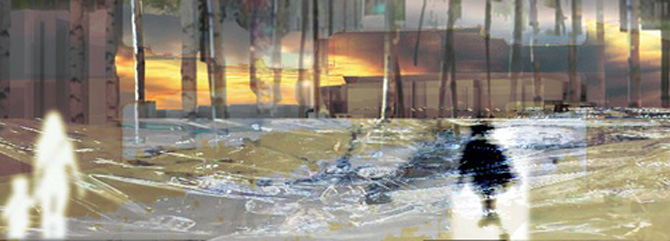Universidad Europea de Madrid
15 - 28 June 2009

The transformation 'from solid to liquid modernity has created a new and unprecedented setting... (where) social forms and institutions no longer have enough time to solidify and cannot serve as frames of reference for human actions... In liquid modernity the individual must act... under conditions of endemic uncertainty.
- Zygmunt Bauman, 'Liquid Modernity', Cambridge 2000.
Berlin's urban setting is seen as an open field where relationships amongst communities can be understood as a continuous process. Adopting four distinct media, Students and professors from UEM are developing proposals for urban reconfiguration along the River Spree in the socio-economically charged context of Berlin's Kreuzberg. The space to be transformed is the area between Wiener Str., Glogauer Str. and Paul-Lincke Ufer, on the corner of Kreuzberg , overlooking the Landeswehrkanal.
Staff: Begoña Diaz-Urgorri, Jose L. Esteban, Angel L. Fernandez, Concha Lapayese, Juan J. Mateos, Beatriz Matos, Fermin Vazquez
Guest Critics: Mathias Sauerbruch, David Chipperfield, Frank Barkow, Lukas Feireiss, Fernando Menis, Enrique Sobejano, Fuensanta Nieto, Carsten Joost, Nancy Couling, Paola Alfaro, Takis Sgouros, Claus Käpplinger, Nikolaus Bernau
Special Thanks: E. Alvarez-Sala Gomez-Morán, Itziar Taboada, Raul Gomez Valverde, Pablo Puyol
Students: Alvaro Lopez Rodriguez, Alejandra Valera Martínez, Huberto Aldaz, Paloma Hendel, Rocio Romo Torres, Fabiola Marroyo, María Teresa Pinilla Mora, Marta Torrecillas, Iván Guerrero Jiménez, Marina Rodriguez Sotoca, Carlos Martínez Pérez, Marta Gutierrez, Nuria Romo Torres, Victor Amengual, David Salcedo, Ruben Garcia de Valle, Mª Pilar Santorroman

The conflict between the borders of the Spree River is a fight between two enemies: the real estate promoters and the real estate detractors. The Mediaspree project is an important point of conflict between both sides. To the eyes of the city council and the promoters it is a form of urban development that will generate money and jobs. On the other hand, for the 30,000 citizens who have been united by the cause “Sink the Mediaspree”, the height and density of buildings so close to the riverbanks will only undermine Kreuzberg's creative roots and destroy the river's natural habitats. For them, the site of O2 World has become a symbol of disastrous urban planning.
The conflict is ongoing with no sign of happy resolution, unless an agreement can be reached which benefits both sides. This project embraces this ideology to create a joint space on both sides of the Spree.
The space is comprised of dynamic platforms of varying uses, united and separated according to different programmatic possibilities. This creates a flexible system for the physical, social and spiritual connection of the river's banks. Throwing objects is how the union of Spree River is constructed.

Since our group was assigned to work with physical models, our proposal is based on the plasticity of the materials used.
The main idea of our proposal was to break down the visual barrier of the Berlin Wall, which currently dominates the site. To give form to this idea, we used a complex geometry derived from the unpredictable movement of fluids.
By recording our process, the geometry was parameterized so as to continuously underpin our working method. Having defined the flood areas, the rest of the site was programmatically organised in accordance with the parametric analysis.
Sound mapping defined the new topography so that observation points would be superimposed on the silent areas of the site.
On the other hand, the density model is used to define the access points from the city and the flowing patterns of the rivers.

This project is located in the neighborhood of Kreuzberg, Berlin. Our intervention begins with the study of the city. As Germany's capital, Berlin is creating new zones of development out of scale with the urban landscape.
The “urban activation kit” uses the river as a way to introduce and enhance the life of the neighborhood fostering a dialogue between city and river.
Different platforms flowing through the river at certain moments support the city's amazing atmosphere.
A geometric mesh will be positioned in strategic locations in the water, offering cultural, commercial and leisure activities. Sometimes connecting water and land, others are generating temporary spaces for citizens.
The interaction of these three layers of public spaces with changing uses has the capacity to adapt to Berlin's ever-shifting urban life.


